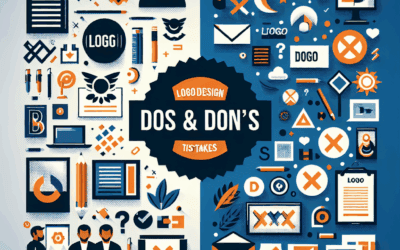In today’s fast-paced business world, a strong visual identity can make or break a brand. The logo, often the most recognizable component of a brand’s image, plays a pivotal role in shaping consumer perceptions. When companies decide it’s time for a logo makeover, they’re not just changing a graphic; they are engaging in a comprehensive rebranding effort. In this article, we take you behind the scenes of a logo makeover, exploring how designers illuminate the process of crafting a brand’s new image.
The Importance of a Logo in Brand Identity
A logo is more than just a pretty picture; it is the face of the brand. It conveys the essence of the company and influences how consumers feel about it. According to a study from the American Marketing Association, consistent presentation of a brand can increase revenue by 23%. Therefore, a logo makeover is a significant decision, often undertaken to revitalize a brand, attract new customers, or modernize its image.
Deciding on a Logo Makeover
The decision to initiate a logo makeover can stem from various factors, including shifts in company philosophy, market trends, or a desire to connect with a younger audience. For instance, when businesses notice that their logo appears outdated or fails to resonate with current consumer expectations, a redesign becomes crucial.
Research and Discovery Phase
The logo makeover process commonly begins with a research and discovery phase. Designers work closely with the brand to understand its core values, mission, and target audience. This step is crucial, as it sets the foundation for the entire project. In-depth analysis often includes:
- Competitor analysis to identify industry trends and consumer preferences.
- Surveys and focus groups to gather feedback from both employees and customers.
- Evaluating current branding to determine what elements resonate with consumers.
Defining the Brand’s Vision
Once the research phase concludes, the next step is to define the brand’s vision. This involves distilling the company’s attributes into a set of guiding principles that will inform the design process. For example, a tech startup aiming to appeal to a younger demographic might prioritize innovation and modern aesthetics, while a traditional retail brand may lean towards heritage and reliability.
The Creative Process: Sketching Ideas
Now comes the fun part: the creative process. Designers typically start by sketching initial ideas, exploring different shapes, symbols, and typography. Inspiration can come from various sources, including nature, architecture, and art. This stage often includes:
- Brainstorming sessions with the design team.
- Creating mood boards that represent visual styles and themes.
- Sketching numerous concepts before narrowing them down for digital refinement.
Digitizing the Concept
After selecting promising sketches, designers transition to digital tools. Software such as Adobe Illustrator allows them to create vector graphics, which are essential for producing high-quality logos that can be resized without losing clarity. During this phase, elements like color schemes, typography, and layout are finalized.
The Role of Color and Typography in Design
Color and typography are crucial elements in a logo makeover. Colors evoke emotions and can strongly influence brand perception. For instance, blue can convey trust and security, while red represents excitement and energy. On the other hand, the choice of typefaces conveys personality; serif fonts often evoke tradition and reliability, while sans-serif fonts project a modern and friendly image.
Testing and Client Feedback
Once the digital designs are ready, the next step involves presenting them to the client. This stage includes gathering feedback and possibly conducting A/B testing to see which versions resonate more with the target audience. Designers must remain open to critique and willing to iterate based on the client’s vision and market research results.
Refining the Design
Refinement is an essential part of the process. Designers may go through several rounds of revisions to address feedback and improve the logo. This could involve adjusting color palettes, tweaking fonts, or even completely rethinking certain elements. The goal is to ensure that the final design aligns with the brand’s core values while appealing to potential customers.
Finalizing and Launching the New Logo
After final adjustments, the logo is finalized and prepared for launch. This includes creating various file formats for different applications, from digital platforms to print media. A well-executed launch plan may involve a marketing campaign to introduce the new logo, explaining the reasons behind the makeover to consumers and emphasizing the brand’s evolution.
Conclusion: The Lasting Impact of a Logo Makeover
A logo makeover is not merely a cosmetic change; it is a strategic business move that can redefine a brand’s identity and influence consumer perceptions. By understanding the design process—from research and conceptualization to final execution—brands can rejuvenate their image in a manner that continues to resonate with their audience. Therefore, when executed thoughtfully, a logo makeover can serve as a catalyst for renewed growth and opportunity in an ever-changing marketplace.
In the competitive world of branding, ensuring that your logo aligns with your company’s goals and values is paramount. Whether you’re considering a makeover for the first time or simply looking to refresh your image, understanding the intricate workings of logo design will help you effectively communicate your brand’s story to the world.
At USA Marketing Pros, we specialize in boosting your online presence with expert web design, SEO, and digital marketing solutions. Based in Arlington, VA, we proudly serve businesses across Northern Virginia and the wider Washington, DC area. Contact us today to see how we can help your business grow at (202) 888-5895 or visit us at 701 12th St S, Arlington, VA 22202.
Looking for Custom Logo Design? View our Logo Design Service
Check out all our Digital Marketing Services
Complimentary Logo Design Strategy Call




0 Comments